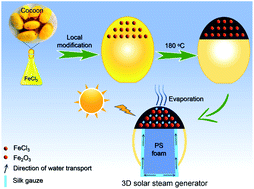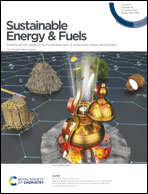A cocoon-based 3D solar steam generator for high-performance saline water desalination†
Abstract
Interfacial solar steam generation (ISSG) provides a facile and sustainable strategy for freshwater production from seawater. To further enhance steaming efficiency, exploration of novel photo-thermal materials and optimization of their heat transfer are two important considerations. However, for most steam generators, the exquisite design of their intrinsic evaporation architecture was less discussed, which in turn seriously reduced their solar-to-vapor conversion efficiency. In this study, a 3D steam generator that demonstrates intrinsic bi-functional areas (light absorption and thermal management) is prepared by local modification of cocoons at low temperatures. The obtained steam generator exhibits an evaporation rate as high as 1.44 kg m−2 h−1, and its heat conduction loss was reduced significantly to only 0.9%. More importantly, the intrinsic 3D structures of cocoons can help to maintain high evaporation rates of generators as the light incident angles varied from 0–90°, which facilitates their practical use, i.e. under moving sun. This work provides a paradigm shift to design cost-effective, high-efficiency and eco-friendly steam generators for high-performance saline water desalination.



 Please wait while we load your content...
Please wait while we load your content...